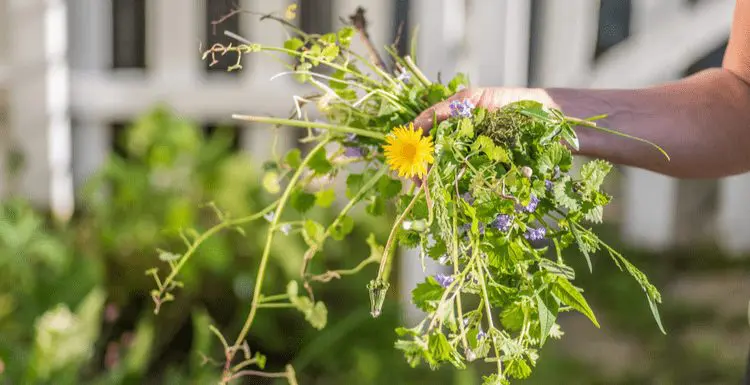Curious as to how to get rid of purple flowers in your yard? Not to worry, we’ll discuss some of the purple flowers (read as weeds) you may encounter on your lawn and how to eradicate them.
Purple is undoubtedly a beautiful and soothing color, but it can make you feel the opposite of calm when it pops up all over the lawn that you work hard to keep in immaculate condition.
How to Get Rid of Purple Flowers in 3 Steps
Sure, purple flowers can be pretty, but if they come in the form of a weed that’s harming your lawn or garden, you may want to get rid of them. The following are the things to consider when doing so:
Step 1: Identify the Flowering Plant
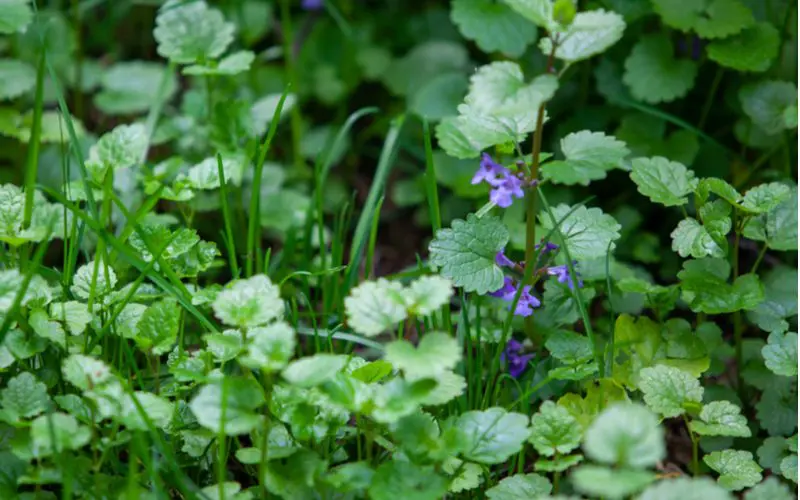
Bart Groundhog/Shutterstock
To know the best method to eliminate purple weeds, you should first understand what kind of weed you’re dealing with. There’s more than one flowering purple plant out there, so identifying the species is vital before you start trying to kill it off.
Otherwise, you may wind up harming your lawn or garden without doing any damage to the plant itself.
You’ll want to check around your yard to see whether any purple flowers present are either ones that you’ve planted intentionally or ones that sprouted against your will.
If the flowers grew there without you knowing, it’s safe to say they’re weeds, and it would be wise to get rid of them so they don’t potentially choke out your other plants.
Once you have located the plants, you can identify them by their physical characteristics. Here are several common types of purple flowering weeds and some descriptions of them, so you know what to look for:
- Creeping Charlie, sometimes known as Ground Ivy, is a member of the mint family and has broad, scalloped leaves.
- Another member of the mint family, purple dead nettle, has a square stem and flowers towards the top of the plant.
- You can identify a wild violet by its heart-shaped leaves and thin stem. The flowers are a vibrant purple.
- Henbit looks like fuzzy little clumps of purple buds and leaves.
There are certainly more types of purple flowers than this, so do your best research before you try to treat the plants.
Step 2: Determine the Right Treatment and Apply
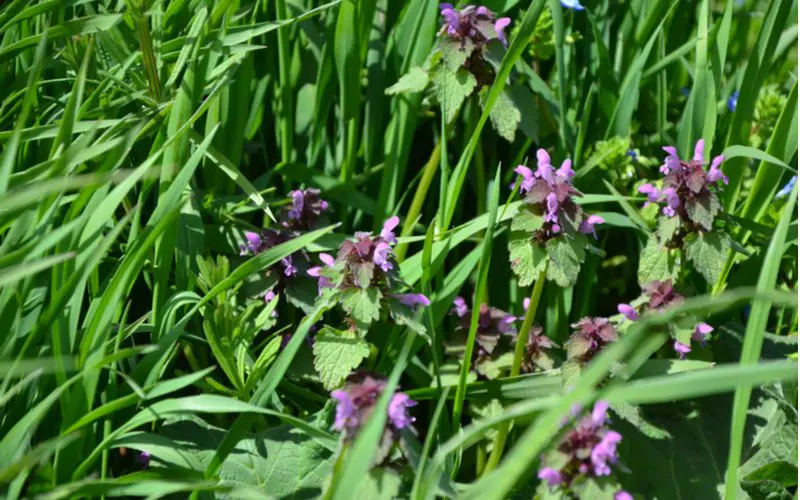
Vojtech.Postulka/Shutterstock
After you have correctly identified the weed, you can begin figuring out how to get rid of it. Different plants respond better to certain types of treatment, so you should know what to use to get the best results.
Here are some eradication methods that should work well on purple flowers.
Herbicides And Chemicals
You can kill off many weeds through the use of chemical weed killers. The larger your infestation, the more necessary it may be to use chemicals.
However, chemicals can also damage your lawn or other plants in your garden, so make sure to read the label on any weed killer you purchase and apply it with care.
If the product contains glyphosate, it will kill most plants. Consider applying a localized amount to only the plants you want to kill rather than spraying and risking other plants in the area.
Pulling
If you only have a few flowering weeds growing, it may be more time- and cost-effective to simply pull them up with your hands or a weed-pulling tool.
You can add water to the area around the weeds to soften the soil, then put on a pair of gloves and yank those invaders out.
You’ll want to grasp the plant at its very base and do your best to take as much of the root system as possible to keep the plant from growing back.
Mulching
You’ve probably seen landscaped areas outside of businesses and neighborhoods with small planted sections covered in mulch or pine straw.
These layers are protective and help to prevent weeds from growing. You can apply a thick layer of straw, hay, or mulch to help choke out purple flowers and other kinds of weeds.
You can purchase mulch at the store, or you can make your own with grass clippings and other organic mulch sources.
Fire
It may sound unorthodox, but think about it. Fire destroys plants and will undoubtedly do the same to any purple weeds that give you trouble.
You just have to make sure to control the burn. A small propane torch is an excellent option for keeping any flames localized, and there are even flame-weeding tools you can purchase as well.
Simply burn away any unwanted plants. This method works very well in areas where you can’t use mulch, such as stone pathways in your yard. But be extremely careful with this one. It is fire, after all.
Lawn And Garden Health
Of course, a few purple flowers don’t mean that your lawn or garden is unhealthy. But you can use keeping an abundantly healthy lawn to your advantage.
Encourage your lawn to grow thickly by using fertilizers and being sure to fertilize at the appropriate seasonal markers for optimum growth.
Keep your grass and garden watered, and keep plants growing close together. Healthy grass and plants will soak up all the moisture and nutrients, leaving little behind for any weeds to sprout.
And having plants grow tightly next to each other can make it too shady for flowering weeds to flourish.
Step 3: Repeat As Necessary
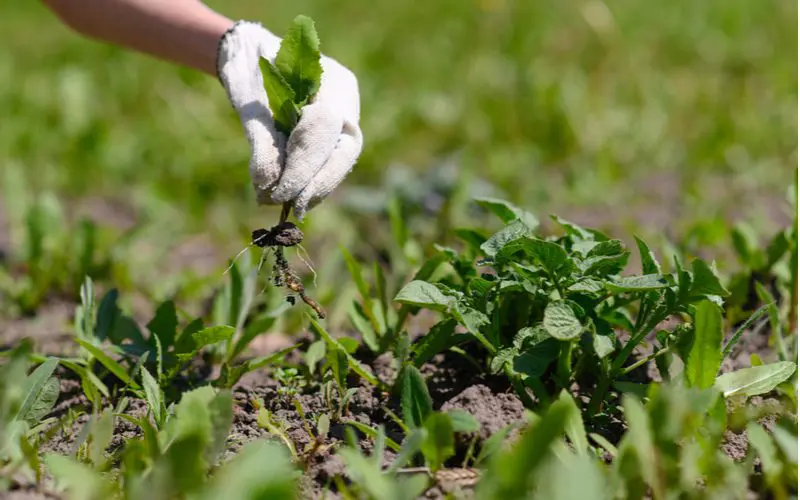
Nikita Burdenkov/Shutterstock
Caring for gardens and lawns is a constant task, and so is getting rid of any weeds that plague them. At the very minimum, you’ll likely have to continue employing your chosen method of weed control each season.
As long as you are diligent and have a good routine in place, you should be able to get rid of any purple flowers and stop them from spreading and becoming a more extensive infestation.
Things to Consider
Now that you’ve seen different methods of getting rid of purple flowers and weeds, here are a few things to keep in mind:
- When using any chemical method of killing weeds, make sure to wear gloves, eye protection, and a mask. You don’t want to breathe in any harmful chemicals or risk a breeze blowing herbicide in your eyes.
- You may find it helpful to get familiar with the growing seasons of the purple plants you’re dealing with and when they’ll be most susceptible to your eradication efforts.
- There are many more types of purple flowers than are listed above, so try to research the types in your area as best you can.
So, How Do You Get Rid of Purple Flowers?
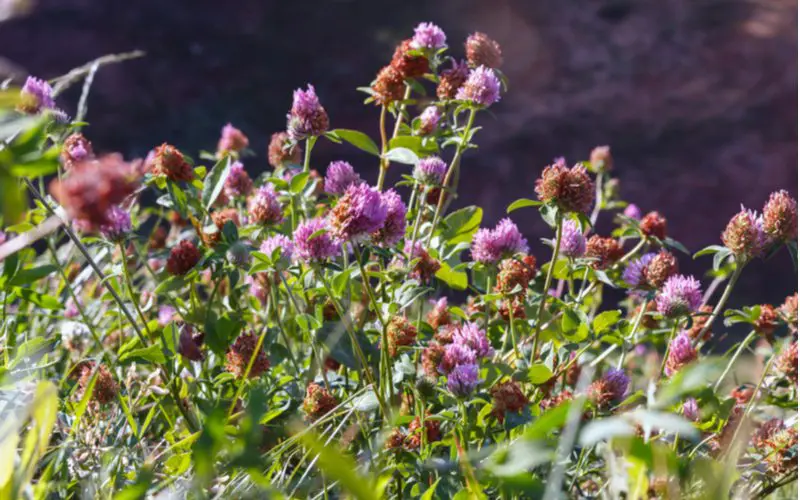
Mykola Churpita/Shutterstock
So, if you’ve caught yourself pondering the methods on how to get rid of purple flowers, it’s clear that there are ways.
With some research and diligence in applying the correct treatments, you can put a stop to purple flowers taking over your yard.
It may take close monitoring of your outdoor landscape, but once you know what to look for and have the tools to treat it, it’s easy to nip weeds in the bud.

